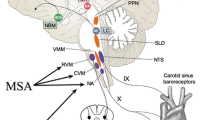Opinion statement
There is no known way to cure multiple system atrophy or even to slow its insidious progression, but there are opportunities to treat many of its symptoms and complications. Of all the autonomic disturbances it causes, orthostatic hypotension is associated with one of the better chances for successful intervention. Milder symptoms may be treated by nonpharmacologic means (eg, changes in diet and activities and compressive maneuvers and devices). Syncopal patients will require treatment with medications. Midodrine is the most effective drug. It is more physiologic and better tolerated, but much more expensive, than fludrocortisone. The latter is often beneficial but frequently causes lower limb edema. Low-dose propranolol is occasionally useful. Other drugs worth trying are indomethacin and intranasal desmopressin. The variety of measures available to treat orthostatic hypotension in multiple system atrophy affords physicians some prospect of easing the suffering of many patients with this otherwise disabling and discouraging disorder.
Similar content being viewed by others
References and Recommended Reading
Dejerine J, Thomas AA: L’atrophie olivo-ponto-cerebelleuse. Nouv Iconog de la Salpetriere 1900, 13:330–370.
Adams RD, Van Bogaert L, Vander Eecken H: Striatonigral degeneration. J Neuropathol Exp Neurol 1964, 23:584–608.
Shy GM, Drager GA: A neurological syndrome associated with orthostatic hypotension. Arch Neurol 1960, 2:511–527.
Graham JG, Oppenheimer DR: Orthostatic hypotension and nicotine sensitivity in a case of multiple system atrophy. J Neurol Neurosurg Psychiatry 1969, 32:28–34.
Wenning GK, Tison F, Ben Shlomo Y, et al.: Multiple system atrophy: a review of 203 pathologically proven cases. Mov Disord 1997, 12:133–147. This is the largest pathologic series of cases of multiple system atrophy ever published.
Gilman S, Low PA, Quinn N, et al.: Consensus statement on the diagnosis of multiple system atrophy. J Neurol Sci 1999, 163:94–98.
Kraft E, Schwarz J, Trenkwalder C, et al.: The combination of hypointense and hyperintense signal changes on T2-weighted magnetic resonance imaging sequences: a specific marker of multiple system atrophy? Arch Neurol 1999, 56:225–228.
Quinn N: Multiple system atrophy—the nature of the beast. J Neurol Neurosurg Psychiatry 1989, (suppl):78–89.
Consensus Committee of the American Autonomic Society and the American Academy of Neurology: Consensus statement on the definition of orthostatic hypotension, pure autonomic failure, and multiple system atrophy. Neurology 1996, 46:1470. This is the most definitive statement regarding the diagnosis of orthostatic hypotension.
Mathias CJ, Kimber JR: Treatment of postural hypotension. J Neurol Neurosurg Psychiatry 1998, 65:285–289. A very good review of the subject is presented in this article.
van Lieshout JJ, ten Harkel AD, Wieling W: Physical manoeuvres for combating orthostatic dizziness in autonomic failure. Lancet 1992, 339:897–898.
Bouvette CM, McPhee BR, Opfer-Gehrking TL, et al.: Role of physical countermaneuvers in the management of orthostatic hypotension: efficacy and feedback augmentation. Mayo Clin Proc 1996, 71:847–853.
Wright RA, Kaufmann HC, Perera R, et al.: A doubleblind, dose-response study of midodrine in neurogenic orthostatic hypotension. Neurology 1998, 51:120–124.
Low PA, Gilden JL, Freeman R, et al.: Efficacy of midodrine vs placebo in neurogenic orthostatic hypotension. JAMA 1997, 277:1046–1051.
Brevetti G, Chiariello M, Giudice P, et al.: Effective treatment of orthostatic hypotension by propranolol in the Shy-Drager syndrome. Am Heart J 1981, 102:938–941.
Kochar MS, Itskovitz HD: Treatment of idiopathic orthostatic hypotension (Shy-Drager syndrome) with indomethacin. Lancet 1978, 317:1011–1014.
Davies IB, Bannister R, Hensby C, et al.: The pressor actions of noradrenaline and angiotensin II in chronic autonomic failure treated with indomethacin. Br J Clin Pharmacol 1980, 10:223–229.
Senard JM, Rascol O, Durrieu G, et al.: Effects of yohimbine on plasma catecholamine levels in orthostatic hypotension related to Parkinson disease or multiple system atrophy. Clin Neuropharmacol 1993, 16:70–76.
Bordet R, Benhadjali J, Libersa C, et al.: Octreotide in the management of orthostatic hypotension in multiple system atrophy: pilot trial of chronic administration. Clin Neuropharmacol 1994, 17:380–383.
Bordet R, Benhadjali J, Destee A, et al.: Octreotide effects on orthostatic hypotension in patients with multiple system atrophy: a controlled study of acute administration. Clin Neuropharmacol 1995, 18:83–89.
Kaufmann H, Oribe E, Yahr MD: Differential effect of L-threo-3,4-dihydroxyphenylserine in pure autonomic failure and multiple system atrophy with autonomic failure. J Neural Transm 1991, 3:143–148.
Kaufmann H: Could treatment with DOPS do for autonomic failure what DOPA did for Parkinson’s disease? Neurology 1996, 47:1370–1371.
Alexander HE, McCarty K, Giffen MB: Hypotension and cardiopulmonary arrest associated with concurrent haloperidol and propranolol therapy. JAMA 1984, 341:543–544.
Author information
Authors and Affiliations
Rights and permissions
About this article
Cite this article
Riley, D.E. Orthostatic hypotension in multiple system atrophy. Curr Treat Options Neurol 2, 225–230 (2000). https://doi.org/10.1007/s11940-000-0005-2
Issue Date:
DOI: https://doi.org/10.1007/s11940-000-0005-2




